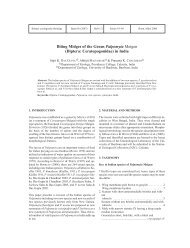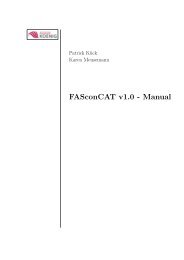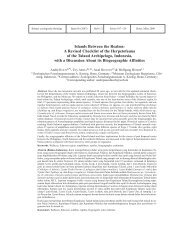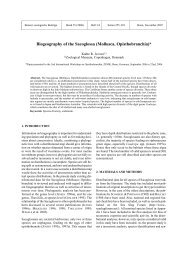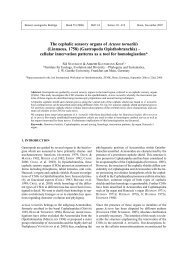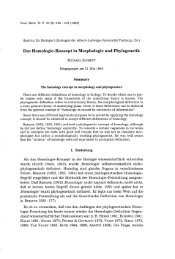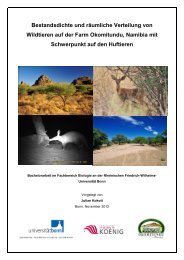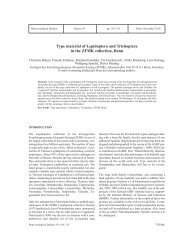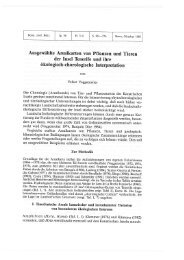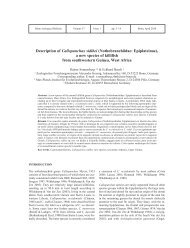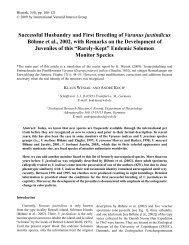Species Composition of Leaf Beetle Assemblages in Deciduous ...
Species Composition of Leaf Beetle Assemblages in Deciduous ...
Species Composition of Leaf Beetle Assemblages in Deciduous ...
Create successful ePaper yourself
Turn your PDF publications into a flip-book with our unique Google optimized e-Paper software.
Bonner zoologische Beiträge Band 54 (2005) Heft 4 Seiten 305–312 Bonn, Oktober 2006<strong>Species</strong> <strong>Composition</strong> <strong>of</strong> <strong>Leaf</strong> <strong>Beetle</strong> <strong>Assemblages</strong> <strong>in</strong> <strong>Deciduous</strong> Tree Canopies<strong>in</strong> Hungary (Coleoptera: Chrysomelidae) 1Károly VIG 2) & Viktor MARKÓ 3)2) Department <strong>of</strong> Natural History, Savaria Museum, Hungary3) Department <strong>of</strong> Entomology, Corv<strong>in</strong>us University <strong>of</strong> Budapest, HungaryAbstract. The species richness and species composition <strong>of</strong> Coleoptera assemblages were <strong>in</strong>vestigated <strong>in</strong> deciduous treecanopies <strong>in</strong> Hungary. Apple and pear orchards were <strong>in</strong>vestigated <strong>in</strong> Nagykovácsi, Kecskemét and Sárospatak <strong>in</strong> 1990–94, and limes and maples <strong>in</strong> Keszthely <strong>in</strong> 1999–2002. This study presents <strong>in</strong> detail the f<strong>in</strong>d<strong>in</strong>gs on leaf beetles.Earlier <strong>in</strong>vestigations <strong>in</strong> Hungary revealed surpris<strong>in</strong>gly high diversity <strong>of</strong> Coleoptera assemblages <strong>in</strong> the canopy <strong>of</strong> appleand pear orchards. Altogether 324 species, almost 3 per cent <strong>of</strong> Hungary’s beetle fauna, were represented: 253 <strong>in</strong> appleand 188 <strong>in</strong> pear orchards. The majority <strong>of</strong> the species belonged to the Curculionidae, Chrysomelidae and Cocc<strong>in</strong>elidaefamilies. The proportion <strong>of</strong> leaf beetles ranged between 15 and 20 %. The commonest leaf-beetle species <strong>in</strong> the canopy<strong>of</strong> the commercial orchards <strong>in</strong>vestigated were Phyllotreta vittula, Phyllotreta atra, Phyllotreta nigripes, Oulemamelanopus, and Aphthona euphorbiae. In the abandoned orchards, the commonest were Luperus xanthopoda, Smaragd<strong>in</strong>asalic<strong>in</strong>a and Orsodacne l<strong>in</strong>eola.Exam<strong>in</strong>ation <strong>of</strong> the fauna <strong>of</strong> parks, avenues and other planted urban plant stocks has only begun to occupy researchers <strong>in</strong>the last decade. Analysis <strong>of</strong> the full Arthropoda assemblages <strong>of</strong> these plant stocks has still not been undertaken. Theproportion <strong>of</strong> leaf-beetle species <strong>in</strong> the material gathered on maples and limes <strong>in</strong> Keszthely ranged between 17.0 and21.3 per cent. Apart form leaf beetles, the bulk <strong>of</strong> the specimen material collected consisted <strong>of</strong> species <strong>of</strong> the Cocc<strong>in</strong>ellidae,Staphyl<strong>in</strong>idae and Curculionidae families. The commonest leaf-beetle specimens collected <strong>in</strong> the lime canopy wereAphthona euphorbiae, Chaetocnema tibialis, Longitarsus lycopi, Longitarsus pellucidus, Longitarsus pratensis andLongitarsus succ<strong>in</strong>eus. The commonest on maple were Aphthona euphorbiae, Chaetocnema conc<strong>in</strong>na, Chaetocnematibialis, Longitarsus lycopi, Longitarsus pellucidus, Longitarsus succ<strong>in</strong>eus, Phyllotreta cruciferae and Phyllotreta vittula.It was concluded that leaf beetles contribute a high proportion <strong>of</strong> the biodiversity <strong>of</strong> the deciduous tree canopy, sometimesoccurr<strong>in</strong>g with high species richness and abundance. However, the reasons for this occurrence and their potentialrole are poorly understood.Key words. Coleoptera, Chrysomelidae, Hungary, faunistics, deciduous tree canopy fauna1. INTRODUCTIONAttention focused on apple and pear orchards dur<strong>in</strong>g thedevelopment <strong>of</strong> <strong>in</strong>tegrated plant-protection methods.Knowledge <strong>of</strong> the biology <strong>of</strong> some key pests and predators(BALÁZS 1992; BLOMMERS 1994; HERARD 1986) isextensive enough to describe the role <strong>of</strong> these organisms<strong>in</strong> the ecological processes <strong>of</strong> such orchards. Yet thespecies composition and diversity <strong>of</strong> the total arthropodassemblages are still poorly known, although the <strong>in</strong>formationcould be essential to a general understand<strong>in</strong>g <strong>of</strong>the biodiversity relations <strong>of</strong> the plantations.Two long-term <strong>in</strong>vestigations <strong>of</strong> the arthropod fauna <strong>of</strong>apple orchards <strong>in</strong> Hungary have been carried out <strong>in</strong> thelast century (ZILAHI-SEBESS 1955; MÉSZÁROS 1984).An additional <strong>in</strong>vestigation focused on the Coleopteraassemblages <strong>of</strong> apple and pear orchards <strong>in</strong> Hungary(MARKÓ et al. 1995).1Paper presented to the 6 th International Symposium on the Chrysomelidae,Bonn, Germany, May 7, 2004.Exam<strong>in</strong>ation <strong>of</strong> the fauna <strong>of</strong> parks, avenues and otherplanted urban plant stocks has only begun to occupy researchers<strong>in</strong> the last decade. This research had severalobjectives, but plant-protection criteria were dom<strong>in</strong>ant.Nonetheless, analysis <strong>of</strong> the full Arthropoda assemblages<strong>of</strong> these plant stocks has still not been undertaken.This study aims to compare the leaf-beetle samples collected<strong>in</strong> the canopy <strong>of</strong> deciduous trees <strong>in</strong> Hungary andexpla<strong>in</strong> the similarities and differences between thesamples.2. MATERIALS AND METHODSInvestigations <strong>of</strong> the canopy fauna <strong>of</strong> apple and pear orchardswere carried out <strong>in</strong> three geographical regions <strong>of</strong>Hungary. The samples were collected at the follow<strong>in</strong>glocalities. Nagykovácsi (3 plots) is situated <strong>in</strong> the centre<strong>of</strong> Hungary <strong>in</strong> woodland amidst hills <strong>of</strong> medium heightand surrounded by mixed oak forest. Kecskemét (5plots), situated <strong>in</strong> the Great Hungarian Pla<strong>in</strong>, and Sáro-
306 Bonner zoologische Beiträge 54 (2005)spatak (4 plots) <strong>in</strong> Northern Hungary both lie <strong>in</strong> a lowlandagricultural environment. Some <strong>of</strong> the selectedplots had been untreated, and others treated with broadspectrum<strong>in</strong>secticides (ma<strong>in</strong>ly organophosphorus <strong>in</strong>secticidesand pyrethroids), and also treated with selective<strong>in</strong>secticides (ma<strong>in</strong>ly IGR pesticides) <strong>in</strong> IPM orchards.The samples restricted to the canopies were collectedbetween 1990 and 1994, from April to November, bybeat<strong>in</strong>g methods, us<strong>in</strong>g the W<strong>in</strong>kler-type umbrella (Ø0.7 m) or 0.25 m 2 plastic sheet. Sampl<strong>in</strong>g per year variedbetween 12 and 22 occasions. The number <strong>of</strong> treesper sampl<strong>in</strong>g varied between 10 to 30. Table 1 showsthe parameters <strong>of</strong> each area <strong>in</strong>vestigated.Table 1. Description <strong>of</strong> the orchards <strong>in</strong>vestigated <strong>in</strong> Hungary (after MARKÓ et al. 1995)Woodland <strong>in</strong> hill <strong>of</strong> medium heightAgricultural lowlandNagykovácsi Kecskemét SárospatakFruit species apple pear pear apple apple apple pearAge <strong>of</strong> plantation M M M Y Y M MSize <strong>of</strong> plantation 5.8 ha 1.1 ha 51 ha 2 ha 2 ha 5–6 ha 50.6 haUntreated + +Conventionally+ + + + +treatedIPM applied + + + +No. <strong>of</strong> treatments – – 3–6 7–8 7–8 7–8 7–8Collect<strong>in</strong>g method U U U U S U UYears 1990–92 1992–4 1992–4 1992–3 1992–4 1992–4 1993–4Sampl<strong>in</strong>g per year 12 12 12 12 23–24 21–22 4/19937/1994Trees per sampl<strong>in</strong>g 10 10 12 10 30 branches 10 10M = mature tree, more than 13 years old; Y = younger than 13 years old; U = umbrella; S = plastic sheetInvestigation <strong>of</strong> lime and maple canopies was carriedout <strong>in</strong> Keszthely and vic<strong>in</strong>ity <strong>in</strong> 1999–2002. Keszthelylies <strong>in</strong> the middle <strong>of</strong> Western Hungary at the westernend <strong>of</strong> Lake Balaton, <strong>in</strong> a basically agricultural lowlandenvironment. Collections were made 8–10 times dur<strong>in</strong>gthe vegetation period, us<strong>in</strong>g pyrethroid spray<strong>in</strong>g <strong>of</strong> thewhole canopy and canopy nett<strong>in</strong>g (Ø = 0.5 m). Thenumber <strong>of</strong> trees per sampl<strong>in</strong>g varied between 4 to 10.The composition <strong>of</strong> the chrysomelid communities wascompared by metric ord<strong>in</strong>ation (pr<strong>in</strong>cipal coord<strong>in</strong>ateanalysis—PCoA), based on the Horn <strong>in</strong>dex, after log2transformation <strong>of</strong> the data, and the Jaccard similarity <strong>in</strong>dex(KREBS 1989), us<strong>in</strong>g the Syntax 5.1 program (PO-DANI 1997). The start<strong>in</strong>g data for these analyses wereobta<strong>in</strong>ed by aggregat<strong>in</strong>g all the <strong>in</strong>dividuals collected <strong>in</strong>the canopy <strong>of</strong> the orchard <strong>in</strong>vestigated (apple and pear)or tree species (lime and maple).3. RESULTSTables 2, 3, 4 and 5 show the results obta<strong>in</strong>ed <strong>in</strong> thecanopies <strong>of</strong> the apple and pear orchards. There were atotal <strong>of</strong> 253 Coleoptera species <strong>in</strong> the canopies <strong>of</strong> appletrees and 188 Coleoptera species <strong>in</strong> those <strong>of</strong> pear trees(MARKÓ et al. 1995). At Nagykovácsi, altogether14,917 specimens <strong>of</strong> Coleoptera were collected, <strong>of</strong>which 756 specimens were leaf beetles; there were 176Coleoptera species collected, <strong>of</strong> which 36 were leafbeetlespecies (Table 2). The number <strong>of</strong> leaf-beetlespecimens collected <strong>in</strong> Nagykovácsi <strong>in</strong> 1990–94 appears<strong>in</strong> Table 3. The commonest leaf-beetle species <strong>in</strong> thecanopy <strong>of</strong> conventionally treated pear orchard were Luperusxanthopoda (Schrank, 1781), Phyllotreta atra(Fabricius, 1775), Phyllotreta nigripes (Fabricius, 1775)and Phyllotreta vittula (Redtenbacher, 1849). In theabandoned apple orchards, the commonest was L. xanthopoda,while <strong>in</strong> the untreated pear orchard, the commonestwere L. xanthopoda, Smaragd<strong>in</strong>a (Monrosia)salic<strong>in</strong>a (Scopoli, 1763) and Orsodacne l<strong>in</strong>eola (Panzer,1794). The high proportion <strong>of</strong> L. xanthopoda <strong>in</strong> all orchardswas probably due to the large number <strong>of</strong> wildcherry trees <strong>in</strong> the surround<strong>in</strong>g mixed oak forest. It is <strong>in</strong>terest<strong>in</strong>gthat the number <strong>of</strong> P. vittula was high <strong>in</strong> theconventionally treated pear orchards <strong>in</strong> the years <strong>in</strong>vestigated.This leaf beetle is not a pear-feed<strong>in</strong>g phytophagousspecies, its diet be<strong>in</strong>g restricted to cruciferousplants and grasses (VIG 1998). The reason <strong>of</strong> its occurrence<strong>in</strong> the pear canopy is unknown.
Károly VIG & Viktor MARKÓ: <strong>Leaf</strong> <strong>Beetle</strong>s from Tree Canopies <strong>in</strong> Hungary 307Table 2. Number <strong>of</strong> Coleoptera specimens and species collected <strong>in</strong> apple and pear-orchard canopies <strong>in</strong> Nagykovácsi, Hungary(1990–94)A B C TotalTotal Coleoptera specimens 7,430 4,506 2,981 14,917Total Coleoptera species 125 95 70 176No. <strong>of</strong> Chrysomelidae specimens 168 181 407 756No. <strong>of</strong> Chrysomelidae species 24 17 19 36A = untreated pear (1990–92); B = untreated apple (1990–92); C = conventionally treated pear (1992–4)Table 3. Number <strong>of</strong> leaf-beetle specimens collected <strong>in</strong> apple and pear-orchards <strong>in</strong> Nagykovácsi, Hungary (1990–94)<strong>Species</strong> A B C <strong>Species</strong> A B CAltica sp. – 17 3 Luperus xanthopoda (Schrank,1781)52 133 57Altica oleracea (L<strong>in</strong>naeus, 1758) – – 1 Orsodacne l<strong>in</strong>eola (Panzer, 1794) 31 – 1Aphthona euphorbiae (Schrank,1781)Cassida (s. str.) flaveola Thunberg,1794Cassida (s. str.) nebulosa L<strong>in</strong>naeus,1758Chaetocnema (Tlanoma) conc<strong>in</strong>na(Marsham, 1802)Chaetocnema (Tlanoma) tibialis(Illiger, 1807)Clytra laeviuscula (Ratzeburg,1837)Crepidodera aurata (Marsham,1802)Cryptocephalus (s. str.) hypochaeridis(L<strong>in</strong>naeus, 1758)Cryptocephalus (Burl<strong>in</strong>ius)chrysopus Gmel<strong>in</strong>, 1790Cryptocephalus (s. str.) imperialisLaichart<strong>in</strong>g, 1781Cryptocephalus (s. str.) nitidus(L<strong>in</strong>naeus, 1758)Cryptocephalus (s. str.) nitidus(L<strong>in</strong>naeus, 1758)Gastrophysa polygoni (L<strong>in</strong>naeus,1758)Labidostomis longimana (L<strong>in</strong>naeus,1761)Lachnaia sexpunctata (Scopoli,1763)3 2 6 Oulema melanopus (L<strong>in</strong>naeus,1758)1 – – Pachybrachis tessellatus (Olivier,1791)2 3 51 1 –7 1 1 Phyllotreta atra (Fabricius, 1775) – 1 32– – 6 Phyllotreta cruciferae (Goeze,1777)2 – – Phyllotreta diademata Foudras,18593 – – Phyllotreta nemorum (L<strong>in</strong>naeus,1758)– – 1 Phyllotreta nigripes (Fabricius,1775)1 2 – Phyllotreta nodicornis (Marsham,1802)1 3 – Phyllotreta undulata Kutschera,18603 – – Phyllotreta vittula (Redtenbacher,1849)5 – – Psylliodes (s. str.) tricolor Weise,1888– 3 – Smaragd<strong>in</strong>a (Monrosia) aff<strong>in</strong>is (Illiger,1794)1 – – Smaragd<strong>in</strong>a (Monrosia) aurita(L<strong>in</strong>naeus, 1767)1 – – Smaragd<strong>in</strong>a (Monrosia) salic<strong>in</strong>a(Scopoli, 1763)6 3 – Sphaeroderma testaceum (Fabricius,1775)A = untreated pear (1990–92); B = untreated apple (1990–92); C = conventionally treated pear (1992–4)1 1 7– – 12 3 33 3 341 – –– – 14 – 245– – 1– 1 –1 – –31 3 1– – 1
308 Bonner zoologische Beiträge 54 (2005)Table 4. Number <strong>of</strong> Coleoptera specimens and species collected <strong>in</strong> apple-orchard canopies <strong>in</strong> Kecskemét, Hungary (1992–94)A B C D E TotalTotal Coleoptera specimens 2075 507 474 449 505 4010Total Coleoptera species 85 54 45 39 46 131No. <strong>of</strong> Chrysomelidae specimens 36 24 13 18 16 107No. <strong>of</strong> Chrysomelidae species 14 8 5 7 5 19A = mature, IPM applied; B = mature, conventionally treated with board-spectrum <strong>in</strong>secticides; C = young, conventionally treated; D = young,IPM applied; E = young, IPM appliedTable 5. Number <strong>of</strong> Coleoptera specimens and species collected <strong>in</strong> pear-orchard canopies <strong>in</strong> Sárospatak, Hungary (1993–4)A B TotalTotal Coleoptera specimens 490 427 917Total Coleoptera species 31 31 45No. <strong>of</strong> Chrysomelidae specimens 8 19 27No. <strong>of</strong> Chrysomelidae species 2 5 6A = conventionally treated; B = untreated and IPM appliedTable 6. Number <strong>of</strong> Coleoptera specimens and species and number and proportion <strong>of</strong> leaf-beetle specimens and species collected<strong>in</strong> lime and maple canopies <strong>in</strong> Keszthely, Hungary (1999–2002)A B TotalTotal Coleoptera specimens 4054 2404 6458Total Coleoptera species 182 211 283No. (proportion) <strong>of</strong> Chrysomelidae specimens 266 (6.6%) 441 (18.3%) 707 (10.94%)No. (proportion) <strong>of</strong> Chrysomelidae species 31 (17.0%) 45 (21.3%) 53 (18.73)A = lime; B = mapleAt Kecskemét, altogether 4010 Coleoptera specimenswere collected <strong>of</strong> which 107 specimens were leaf beetlesand there were 131 Coleoptera species collected <strong>of</strong>which 19 leaf beetle species were captured (Table 4.).Interest<strong>in</strong>gly, P. vittula dom<strong>in</strong>ated <strong>in</strong> both the conventionallyand selectively <strong>in</strong>secticide-treated apple orchardsat the end <strong>of</strong> June and <strong>in</strong> mid-July <strong>in</strong> the years<strong>in</strong>vestigated.At Sárospatak, altogether 917 Coleoptera specimenswere collected, <strong>of</strong> which 27 specimens were leaf beetles.There were 45 Coleoptera species represented, <strong>in</strong>clud<strong>in</strong>gsix leaf-beetle species (Table 5).Table 6 summarizes the results obta<strong>in</strong>ed dur<strong>in</strong>g the <strong>in</strong>vestigation<strong>of</strong> the canopies <strong>of</strong> lime and maple trees <strong>in</strong>Hungary. There were a total <strong>of</strong> 182 Coleoptera species<strong>in</strong> the lime canopies and 211 Coleoptera species <strong>in</strong> themaple. At Keszthely, altogether 6458 Coleoptera specimenswere collected, <strong>of</strong> which 707 specimens were leafbeetles. Of the 283 Coleoptera species collected, 53were leaf-beetle species. The commonest leaf beetlespecies <strong>in</strong> the lime canopy were Aphthona euphorbiae(Schrank, 1781), Chaetocnema (Tlanoma) tibialis (Illiger,1807), Longitarsus (s. str.) lycopi (Foudras, 1860),Longitarsus (s. str.) pellucidus (Foudras, 1860), Longitarsus(s. str.) pratensis (Panzer, 1794) and Longitarsus(s. str.) succ<strong>in</strong>eus (Foudras, 1860), and <strong>in</strong> the maplecanopy A. euphorbiae, Chaetocnema (Tlanoma) conc<strong>in</strong>na(Marsham, 1802), C. tibialis, L. lycopi, L. pellucidus,L. succ<strong>in</strong>eus, Phyllotreta cruciferae (Goeze,1777) and P. vittula (Table 7).The results <strong>of</strong> metric ord<strong>in</strong>ations show clear differencesbetween the treatments and tree families. The composition(species composition and relative abundance) <strong>of</strong>leaf-beetle assemblages <strong>in</strong> the canopies <strong>of</strong> untreated appleand pear trees was very similar and dist<strong>in</strong>ct from the
Károly VIG & Viktor MARKÓ: <strong>Leaf</strong> <strong>Beetle</strong>s from Tree Canopies <strong>in</strong> Hungary 309Table 7. Number <strong>of</strong> leaf-beetle specimens collected <strong>in</strong> lime and maple canopies <strong>in</strong> Keszthely, Hungary (1999–2002)<strong>Species</strong> A B <strong>Species</strong> A BAltica oleracea (L<strong>in</strong>naeus, 1758) – 7 Longitarsus (s. str.) lewisii (Baly, 1874) 1 2Aphthona abdom<strong>in</strong>alis (Duftschmid,1825)– 2 Longitarsus (s. str.) luridus (Scopoli,1763)Aphthona euphorbiae (Schrank, 1781) 12 15 Longitarsus (s. str.) lycopi (Foudras,1860)Aphtona nonstriata (Goeze, 1777) – 1 Longitarsus (s. str.) melanocephalus (DeGeer, 1775)Aphthona semicyanea Allard, 1859 – 1 Longitarsus (s. str.) nasturtii (Fabricius,1792)Aphthona venustula (Kutschera, 1861) 2 2 Longitarsus (s. str.) pellucidus (Foudras,1860)Cassida (Mionychella) hemisphaericaHerbst, 1799Cassida (Hypocassida) subferrug<strong>in</strong>eaSchrank, 1776Chaetocnema (s. str.) aridula (Gyllenhal,1827)Chaetocnema (Tlanoma) conc<strong>in</strong>na (Marsham,1802)Chaetocnema (s. str.) hortensis (Ge<strong>of</strong>froy,1785)Chaetocnema (Tlanoma) picipes Stephens,1831Chaetocnema (Tlanoma) tibialis (Illiger,1807)Chrysol<strong>in</strong>a (Menthastriella) herbacea(Duftschmid, 1825)– 3 Longitarsus (s. str.) pratensis (Panzer,1794)1 1 Longitarsus (s. str.) rubig<strong>in</strong>osus (Foudras,1860)– 1 Longitarsus (s. str.) substriatus Kutschera,18637 14 Longitarsus (s. str.) succ<strong>in</strong>eus (Foudras,1860)– 7 Neocrepidodera ferrug<strong>in</strong>ea (Scopoli,1763)7 1019 24– 18 729 3810 11– 51 335 342 65 10 Phyllotreta astrachanica Lopat<strong>in</strong>, 1977 1 617 77 Phyllotreta cruciferae (Goeze, 1777) 9 17– 1 Phyllotreta diademata Foudras, 1859 – 6Clytra laeviuscula (Ratzeburg, 1837) – 2 Phyllotreta nemorum (L<strong>in</strong>naeus, 1758) – 1Crepidodera aurata (Marsham, 1802) 2 3 Phyllotreta nigripes (Fabricius, 1775) 3 10Cryptocephalus (Burl<strong>in</strong>ius) planifrons 1 – Phyllotreta procera (Redtenbacher, 1849) 3 7Weise, 1882Cryptocephalus (s. str.) sericeus (L<strong>in</strong>naeus,1 – Phyllotreta striolata (Fabricius, 1803) – 11758)Epitrix pubescens (Koch, 1803) 2 3 Phyllotreta undulata Kutschera, 1860 1 5Galeruca (s. str.) pomonae (Scopoli, – 1 Phyllotreta vittula (Redtenbacher, 1849) 5 221763)Longitarsus sp. 1 – 1 Psylliodes (s. str.) chrysocephalus (L<strong>in</strong>naeus,1758)2 7Longitarsus sp. 2 1 – Psylliodes (s. str.) illyricus Leonardi & – 1Gruev, 1993Longitarsus (s. str.) kutscherae (Rye,1872)2 1 Psylliodes (s. str.) napi (Fabricius, 1792) 1 1Longitarsus (s. str.) lateripunctatuspersonatus Weise, 1893A = lime (1999–2001; B = maple (1999–2002)2 1 Psylliodes (s. str.) pic<strong>in</strong>us (Marsham,1802)– 1
310 Bonner zoologische Beiträge 54 (2005)Fig. 1. Exam<strong>in</strong>ation <strong>of</strong> the similarity <strong>of</strong> leaf-beetle assemblages gathered on various deciduous trees, by metric ord<strong>in</strong>ation (Horn<strong>in</strong>dex).Fig. 2. Exam<strong>in</strong>ation <strong>of</strong> the similarity <strong>of</strong> leaf-beetle assemblages gathered on various deciduous trees, by metric ord<strong>in</strong>ation (Horn<strong>in</strong>dex, after log2 (x+1) transformation <strong>of</strong> the raw data).
Károly VIG & Viktor MARKÓ: <strong>Leaf</strong> <strong>Beetle</strong>s from Tree Canopies <strong>in</strong> Hungary 311assemblages <strong>of</strong> maple and lime trees (Fig. 1). However,the abandoned orchards were situated <strong>in</strong> the same district(Nagykovácsi) and the maple and lime trees <strong>in</strong> adifferent one (Keszthely). It can also be seen that characteristicchrysomelid assemblages were formed <strong>in</strong>commercial orchards, regardless <strong>of</strong> differences <strong>in</strong> theirsurround<strong>in</strong>gs. On the other hand, the commercial pearorchard2 (No. 6 <strong>in</strong> the figures) is clearly dist<strong>in</strong>ct fromthe abandoned orchards, despite all be<strong>in</strong>g situated <strong>in</strong> thesame district (Fig. 1). The results are similar if theanalysis based on log2 transformed data are compared,or only the species compositions (Jaccard <strong>in</strong>dex). Inthese analysis, the role <strong>of</strong> the commonest, dom<strong>in</strong>antspecies was lower (log2 transformation) or relativeabundance was not taken <strong>in</strong>to consideration (Jaccardsimilarity) <strong>in</strong> the comparisons (Figs. 2 and 3). So the resultsshow the basic structure <strong>of</strong> the chrysomelid assemblages.The neighbour<strong>in</strong>g habitats seem to be more important<strong>in</strong> form<strong>in</strong>g the species composition <strong>of</strong> thechrysomelid assemblages. The species composition <strong>in</strong>the commercial pear orchard2 was closer to the abandonedones from the same location than to the othercommercial orchards. Similarly, the leaf beetle assemblages<strong>in</strong> the canopies <strong>of</strong> lime and maple trees from thesame location, Keszthely show remarkably similarcomposition (Fig. 3).Fig. 3. Exam<strong>in</strong>ation <strong>of</strong> the similarity <strong>of</strong> leaf-beetle assemblages gathered on various deciduous trees, by metric ord<strong>in</strong>ation (Jaccard<strong>in</strong>dex).4. DISCUSSIONThe leaf-beetle assemblages exam<strong>in</strong>ed consist <strong>of</strong> speciesthat sometimes feed on the tree species concernedand much larger specimen and species numbers<strong>of</strong> visit<strong>in</strong>g species. The untreated apple and pearorchards typically had large numbers <strong>of</strong> specimens <strong>of</strong>species feed<strong>in</strong>g on the trees (L. xanthopoda and O.l<strong>in</strong>eola). Treatment obviously <strong>in</strong>creases the proportion<strong>in</strong> the assemblages <strong>of</strong> visit<strong>in</strong>g species less tied toa food plant (pr<strong>in</strong>cipally and sometimes exclusivelyPhyllotreta vittula), and this causes the dist<strong>in</strong>ction <strong>in</strong>the commercial plantations. On lime and maple species,however, visit<strong>in</strong>g species were found almost exclusively,so that the different characteristics <strong>of</strong> thetwo species <strong>of</strong> tree do not give them dist<strong>in</strong>ct beetlefaunas. The tourists have a decisive role <strong>in</strong> speciescomposition. The relatively large number <strong>of</strong> touristspecies (A. euphorbiae, Cassida (s. str.) nebulosaL<strong>in</strong>naeus, 1758, C. conc<strong>in</strong>na, Cryptocephalus (s. str.)nitidus (L<strong>in</strong>naeus, 1758), Lachnaia sexpunctata (Scopoli,1763), Oulema melanopus (L<strong>in</strong>naeus, 1758), P.atra, P. cruciferae, Phyllotreta nemorum (L<strong>in</strong>naeus,1758), P. nigripes, P. vittula and S. (M.) salic<strong>in</strong>a <strong>in</strong>Nagykovácsi and 283 species <strong>in</strong> the case <strong>of</strong> Keszthely)have arrived from the environs, so that the speciescomposition is more similar on trees found <strong>in</strong> thesame environment. The explanation for this, as said
312 Bonner zoologische Beiträge 54 (2005)earlier, is that the environs <strong>of</strong> the trees have the decisiveeffect on the development <strong>of</strong> the species composition.<strong>Leaf</strong> beetles contribute a high proportion <strong>of</strong> the biodiversity<strong>of</strong> the deciduous tree canopy, sometimes occurr<strong>in</strong>gwith high species richness and abundance. However,the reasons for this occurrence and their potentialrole are poorly understood. Most <strong>of</strong> the species are certa<strong>in</strong>lytourists, which arrived <strong>in</strong> the canopy by chance,s<strong>in</strong>ce these tree species are not their food plant. However,it cannot be ruled out that some species may occasionallydraw moisture from the leaves <strong>of</strong> the deciduoustree species exam<strong>in</strong>ed, especially if the ma<strong>in</strong> food planthas become <strong>in</strong>edible. With some species, consumption<strong>of</strong> honeydew or sooty moulds is conceivable, althoughunsupported by observations specific to these species.Acknowledgements. Károly Vig was supported by theJános Bolyai Foundation <strong>of</strong> the Hungarian Academy <strong>of</strong>Sciences.REFERENCESBALÁZS, K. 1992. Proceed<strong>in</strong>gs <strong>of</strong> the <strong>in</strong>ternational symposiumon <strong>in</strong>tegrated plant protection <strong>in</strong> orchards,Gödöllő 1990. Acta Phytopathologica et EntomologicaHungarica 27(1–4): 1–690.BLOOMERS, L. H. M. 1994. Integrated pest management <strong>in</strong>European apple orchards. Annual Review <strong>of</strong> Entomology39: 213–241.HERALD, F. 1986. Annotated list <strong>of</strong> the entomophagouscomplex associated with pear psylla, Psylla pyri (L.)(Homoptera: Psyllidae) <strong>in</strong> France. Agronomie 6(1): 1–34.KREBS, C. J. 1989. Ecological Methodology. Harper andRow Publishers, New York, 654 pp.MARKÓ, V., MERKL, O., PODLUSSÁNY, A., VIG, K., KU-TASI, Cs. & BOGYA, S. 1995. <strong>Species</strong> composition <strong>of</strong>Coleoptera assemblages <strong>in</strong> the canopies <strong>of</strong> Hungarianapple and pear orchards. Acta Phytopathologica et EntomologicaHungarica 30(3–4): 221–245.MÉSZÁROS, Z. (ed.) 1984. Results <strong>of</strong> faunistical and floristicalstudies <strong>in</strong> Hungarian apple orchards. ActaPhytopathologica et Entomologica Hungarica 19: 91–176.PODANI, J. 1997. SYN-TAX 5.1: A new version for PC andMac<strong>in</strong>tosh computers. Coenoses 12: 149–152.VIG, K. 1998. Host plant selection by Phyllotreta vittula(Redtenbacher, 1849). Pp. 233–251 <strong>in</strong>: BIONDI, M.,DACCORDI, M. & FURTH, D. G. (eds.) Proceed<strong>in</strong>gs <strong>of</strong>the Fourth International Symposium on the Chrysomelidae.Proceed<strong>in</strong>gs <strong>of</strong> a Symposium (30 August,1996, Florence Italy), XX International Congress <strong>of</strong>Entomology, Tor<strong>in</strong>o, Museo Regionale di ScienzeNaturali.ZILAHI-SEBESS, G. 1955. Mes recherches faunistiques dansles vergers de Tiszacsege. Acta Universitatis Debreceniensisde Ludovico Kossuth Nom<strong>in</strong>ate 2: 1–15.Authors’ addresses: Károly VIG (correspond<strong>in</strong>g author),Savaria Museum, Department <strong>of</strong> Natural History,H-9700 Szombathely, Kisfaludy S, u. 9., Hungary, E-mail: nathist.savmuz@axelerto.hu; Viktor MARKÓ, Corv<strong>in</strong>usUniversity <strong>of</strong> Budapest, Department <strong>of</strong> Entomology,H-1118 Budapest, Ménesi út 44., Hungary, E-mail:vmarko@omega.kee.hu




